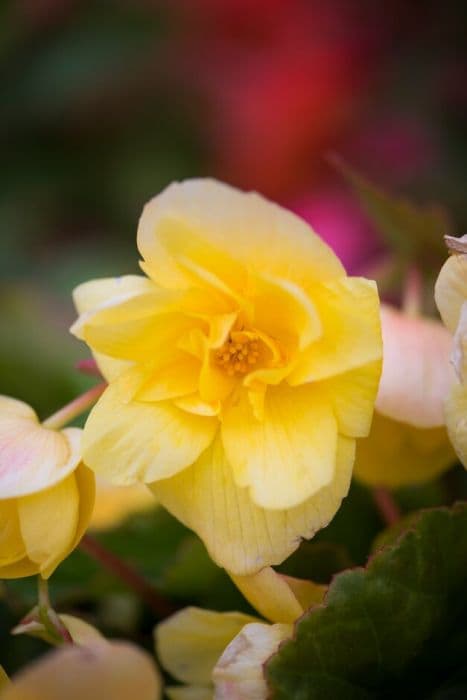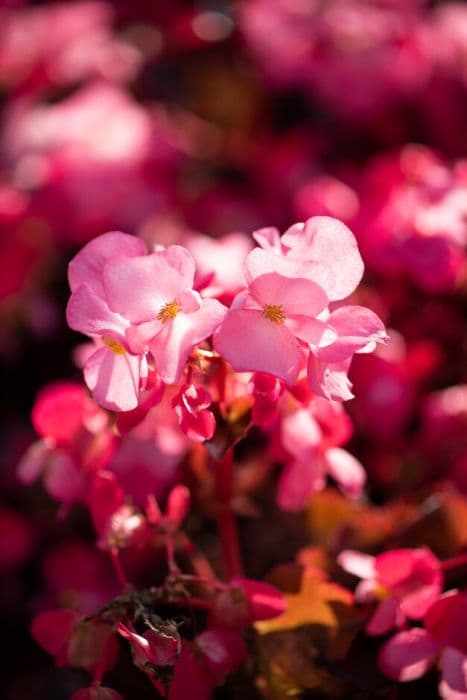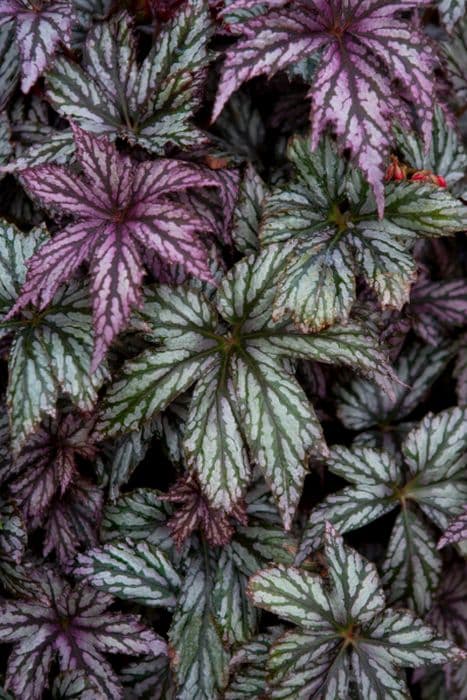Orange Begonia Begonia Fragrant Falls Orange = 'Tmbg1307' (Fragrant Falls Improved Series)
![begonia [Fragrant Falls Orange]](/_next/image?url=https%3A%2F%2Fplants-admin.emdemapps.com%2Fimages%2Fplants%2F%2Fimages%2F604b537c1a26c.png&w=3840&q=75)
ABOUT
The Begonia Fragrant Falls Orange 'Tmbg1307', part of the Fragrant Falls Improved Series, showcases a vibrant display of flowers. The blossoms present a bright orange hue that could be described as warm and inviting, akin to a sunset's radiance. The petals exhibit a delicate, ruffled texture, further accentuating the vivacity of its floral clusters as they cascade generously, creating a visual waterfall of color. The leaves of this begonia provide a lush backdrop for the fiery blooms. They are typically a rich green, contributing a glossy appearance and a fullness to the overall look of the plant. This variety emits a gentle fragrance that would be noticeable, especially as the plant matures and produces an abundance of flowers.
About this plant
 Names
NamesFamily
Begoniaceae
Synonyms
Fragrant Falls Orange Begonia, Orange Scented Begonia
Common names
Begonia 'Tmbg1307'
 Toxicity
ToxicityTo humans
Begonias, including the Fragrant Falls Orange begonia, can be toxic if ingested. The main component causing the toxicity is insoluble oxalates, which can lead to irritation and a burning sensation in the mouth, tongue, and lips. Swelling of the oral tissues, difficulty swallowing, and vomiting might also occur. Contact with the sap can cause skin irritation as well. Immediate medical attention should be sought if any part of the plant is ingested.
To pets
The Fragrant Falls Orange begonia is toxic to pets if ingested. As with humans, the presence of insoluble oxalates can cause symptoms such as oral irritation, drooling, vomiting, and difficulty swallowing in pets. In severe cases, ingestion can lead to kidney failure or other serious complications. Pets showing symptoms of begonia poisoning should be taken to a veterinarian immediately.
 Characteristics
CharacteristicsLife cycle
Annuals
Foliage type
Deciduous
Color of leaves
Green
Flower color
Orange
Height
1-2 feet (30-60 cm)
Spread
1-2 feet (30-60 cm)
Plant type
Herb
Hardiness zones
10
Native area
Tropical South America
Benefits
 General Benefits
General Benefits- Ornamental Appeal: Begonias are well-known for their beautiful foliage and blooms, adding aesthetic value to gardens and indoor spaces.
- Versatility: Suitable for containers, hanging baskets, and garden beds, they can enhance various garden designs and layouts.
- Colorful Flowers: The bright, vivid flowers of Begonia Fragrant Falls Orange can create eye-catching displays.
- Fragrance: As the name implies, this variety offers a pleasant scent, which can be a desirable trait for indoor or outdoor gardening.
- Long Blooming Period: Begonias typically have a long flowering season, providing color from late spring to fall.
- Shade Tolerance: Begonias can thrive in partial shade, making them ideal for spots where many other plants might struggle due to lack of sunlight.
- Low Maintenance: They generally require minimal care beyond regular watering and occasional fertilization, making them suitable for busy or novice gardeners.
 Medical Properties
Medical PropertiesThis plant is not used for medical purposes.
 Air-purifying Qualities
Air-purifying QualitiesThis plant is not specifically known for air purifying qualities.
 Other Uses
Other Uses- Photography Prop: Begonias, with their vibrant colors, can be used as a striking subject or background in macro photography to showcase their natural beauty.
- Edible Garnish: Begonia petals, being edible, can add a citrusy taste and a pop of color when used as a garnish on salads and desserts.
- Artistic Inspiration: Artists may use Begonias as a muse for paintings, illustrations, and other forms of visual art due to their unique shape and color.
- Education: Begonias can be included in educational programs about horticulture, teaching about plant care and hybridization processes.
- Handmade Paper: The fibers from Begonia stems and leaves can be incorporated into homemade paper for texture and decoration.
- Botanical Jewelry: Preserved Begonia flowers can be used to create unique, hand-crafted pieces of jewelry like pendants and earrings.
- Eco-friendly Confetti: Dried Begonia petals can serve as biodegradable confetti for celebrations, reducing environmental impact.
- Craft Projects: Begonia leaves and petals can be used in scrapbooking or as stamps to create natural motifs on fabric or paper.
- Natural Dyes: The vibrant colors of the Begonias can be used to make natural dyes for textiles, yarns, and other materials.
- Plant Sculpture: Begonias can be incorporated into living plant sculptures or topiaries in ornate gardens or exhibits.
Interesting Facts
 Feng Shui
Feng ShuiBegonias are often associated with positive energy and can be used to introduce vibrant yang energy into the home. With their bright colors, like the orange blooms of the fragrance begonia, they could be particularly useful in the Fame and Reputation area of the home or any living space where you wish to boost energy, encourage happiness and create a welcoming atmosphere. To adhere to Feng Shui principles, place the Begonia in a well-lit area, but avoid direct sunlight to prevent burning the leaves.
 Zodiac Sign Compitability
Zodiac Sign CompitabilityThe fragrance begonia is not used in astrology practice.
 Plant Symbolism
Plant Symbolism- Caution: In the language of flowers, begonias often signify caution or a warning to be careful, perhaps due to their delicate nature.
- Individuality: Begonias can signify individuality and uniqueness, as they come in many different shapes, colors, and sizes, encouraging an appreciation for differences.
- Gratitude: They can also express gratitude, making them a fitting gift when one wants to show appreciation for someone's help or kindness.
- Harmony: The balancing act of growing begonias (needing good light but not too much sun, requiring humidity but avoiding over-watering) can symbolize the search for harmony in one's life.
 Water
WaterFor the Begonia Fragrant Falls, water thoroughly whenever the top inch of soil feels dry to the touch, which may be approximately once a week, depending on environmental conditions. It's important not to let the plant sit in water, so ensure proper drainage. Use lukewarm water and aim to provide about 8-16 ounces depending on the size of the container and the plant’s needs. During active growing seasons, typically spring through fall, they may need more frequent watering. In winter, reduce watering but do not let the soil become completely dry.
 Light
LightBegonia Fragrant Falls prefer bright, indirect sunlight, so placing them in an east- or west-facing window is often ideal. Direct sunlight, especially during the hot afternoon hours, can scorch their leaves, so avoid placing them in these conditions. They can also do well under fluorescent grow lights if natural light is insufficient.
 Temperature
TemperatureBegonia Fragrant Falls thrive best in temperatures between 60°F and 75°F. They can survive minimum temperatures of 50°F, however, they should not be exposed to anything below that as it can cause harm to the plant. They should also be kept away from drafts, as well as from heating and air conditioning vents to prevent sudden temperature fluctuations.
 Pruning
PruningPruning the Begonia Fragrant Falls encourages bushier growth and removes spent blooms to promote further flowering. Prune the plant in early spring and throughout the growing season as needed by snipping off overgrown or dead stems. Remove wilted flowers regularly to keep the plant looking its best and encourage new blooms.
 Cleaning
CleaningAs needed
 Soil
SoilThe best soil mix for Begonia 'Fragrant Falls Orange’ should be light, rich, well-draining, and slightly acidic to neutral in pH, between 5.5 and 6.5. A mix of peat moss, perlite, and pine bark is ideal for this begonia.
 Repotting
RepottingBegonia 'Fragrant Falls Orange' should be repotted every 1-2 years or when the plant becomes root-bound. Spring or early summer is the best time for repotting this plant.
 Humidity & Misting
Humidity & MistingBegonia 'Fragrant Falls Orange' thrives best in moderate to high humidity levels, ideally between 50% and 70%. Avoid environments that are too dry as this may cause stress to the plant.
 Suitable locations
Suitable locationsIndoor
Place in bright, indirect light with high humidity.
Outdoor
Hang in semi-shaded spot, protect from strong winds.
Hardiness zone
10-11 USDA
 Life cycle
Life cycleThe life cycle of the Begonia Fragrant Falls Orange begins with seed germination, where under warm and moist conditions, the seeds sprout and develop into young seedlings. The seedlings grow into juvenile plants, establishing a root system and foliage through the vegetative growth stage. As the plant matures, it enters the flowering stage, characterized by the production of fragrant orange blooms, which is a signature of the Fragrant Falls Improved Series. Following pollination, the flowers develop into fruits, which contain seeds, completing the reproductive cycle. If conditions are optimal, these seeds can disperse and give rise to new plants, continuing the cycle. Throughout the growing season, the plant requires regular watering, fertilization, and in some climates, it behaves as an annual, completing its life cycle within one year, while in milder climates it may act as a perennial.
 Propogation
PropogationPropogation time
Spring-Early Summer
Propogation: The most popular method for propagating Begoia Fragrant Falls Orange is through stem cuttings. This process typically begins in the spring when the plant's growth is most vigorous. To propagate, a healthy stem with at least a few leaves should be selected. The cutting should be about 4-6 inches long (approximately 10-15 centimeters) and the lower leaves must be removed. The cut end of the stem is then dipped in rooting hormone to encourage root growth and planted in a moist soilless potting mix. The environment should be kept humid, which can be achieved by covering the cutting with a clear plastic bag or dome, and placed in bright, indirect light. Roots usually develop within a few weeks, after which the new plant can be transferred to a regular potting mix and treated as an established begonia.





![Begonia [Devotion]](/_next/image?url=https%3A%2F%2Fplants-admin.emdemapps.com%2Fimages%2Fplants%2F%2Fimages%2F604b58183573b.png&w=640&q=75)



